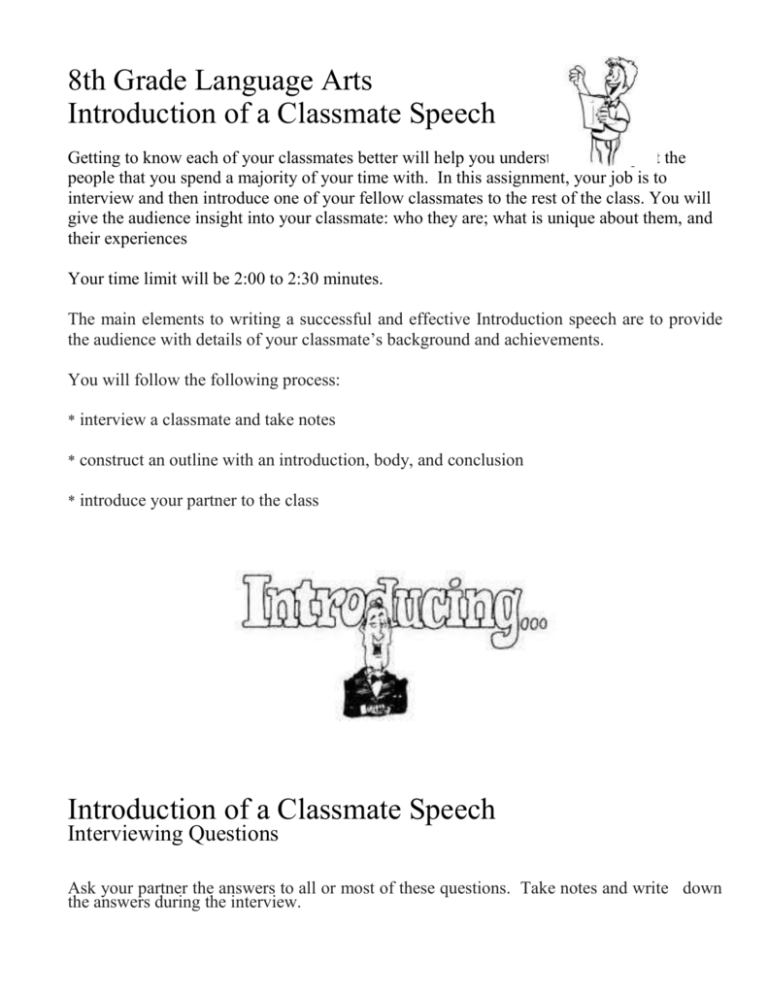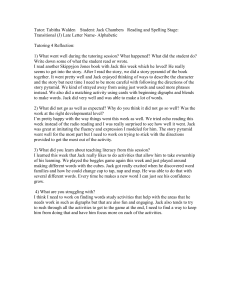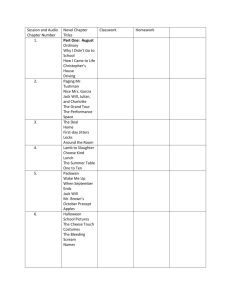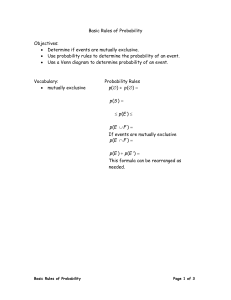8th Grade Language Arts Introduction of a Classmate Speech
advertisement

8th Grade Language Arts Introduction of a Classmate Speech Getting to know each of your classmates better will help you understand and respect the people that you spend a majority of your time with. In this assignment, your job is to interview and then introduce one of your fellow classmates to the rest of the class. You will give the audience insight into your classmate: who they are; what is unique about them, and their experiences Your time limit will be 2:00 to 2:30 minutes. The main elements to writing a successful and effective Introduction speech are to provide the audience with details of your classmate’s background and achievements. You will follow the following process: * interview a classmate and take notes * construct an outline with an introduction, body, and conclusion * introduce your partner to the class Introduction of a Classmate Speech Interviewing Questions Ask your partner the answers to all or most of these questions. Take notes and write down the answers during the interview. (You may delete those you feel are not useful. You may add questions you think up yourself.) ✴ When and where were you born? How old are you now? Who, if anyone, are you named after? ✴ What is your earliest memory? ✴ Who are the other people in your family? ✴ Which member of your family are you most like? Why? How? ✴ In what places have you lived? ✴ What schools have you attended? ✴ What is your father’s occupation? ✴ What is your mother’s occupation? ✴ Who is your best friend(s)? Tell about him/her. ✴ What books and magazines do you like to read? ✴ What person has had the most influence on you? How? ✴ Describe your hobbies. ✴ Describe your pets. ✴ Describe what you like to do in your spare time, and on weekends. ✴ What is your favorite TV program? Why? ✴ What kind of music do you like? ✴ What is the most wonderful thing that ever happened to you? ✴ What is the worst thing that ever happened to you? ✴ What is the most embarrassing thing that ever happened to you? ✴ Where have you traveled? What interesting places have you seen? ✴ Describe your personal talents. What do you do well? ✴ Do you want to go to college? Which one? ✴ What career would you like to pursue as adult? Why? ✴ If you had a choice, where would you spend your time? Why? ✴ What do you like best about school? What do you like least about school? ✴ If you were to be granted one wish, what would you wish for? Introduction of a Classmate Speech Outlining Guidelines 1. Look at the information that you have gathered and try to find a way to organize your main points. For example, if you want to tell your audience about your partners background, education, hobbies you would organize them in that order - first main point = background, second main point = education, third main point = hobbies. It would only make sense to tell us the person’s background first. You should have at least two and no more than three main points for your short introduction speech. 2. Next, look at the information that you have gathered that fits under each main point and come up with key ideas that come under these main points. These will be your sub-points. You need at least two sub-points for each main point. 3. You don’t necessarily need sub-sub-points for your short introduction speech; however, most of you will have sub-sub-points in your speech because these are the facts and information that support what you are saying. You could include a quote from your partner. Sub-sub-points you use for supporting your sub-points - can be personal experiences your interviewee has shared with you. 1. Use transitions throughout your speech. Label and include all transitions in your preparation outline. 2. Follow the guidelines and template for your speech preparation outline. Introduction: I. (Attention Getter) This could be a story or anything you know will GRAB your audience’s attention. “Albert Einstein once said that in the middle of difficulties lie opportunities. We all experience difficulties in our lives; however, what makes some of us different from others is how we deal with the difficulties. The person I will introduce you to today sees difficulties as opportunities.” II. (Reveal Topic) Reveal your topic to your audience–just your topic–not a preview. “Today I have the opportunity to introduce you to Jack Hart, our new classmate.” III. (Credibility Statement) Answer the question, “Why should we listen to YOU?” Give some type of factual information or some reference that will show that you know what you are talking about. This could be the fact that you had an extensive in-class interview with your interviewee. Perhaps you did additional research, or you telephoned your interviewee. “I interviewed Jack in class, and spoke with him on the phone. Before the interview I didn’t know Jack—now I do.” IV. (Preview) Briefly reveal your topic and state what your main points will be. For example: “Today, I will tell you about Jack’s background (main point 1), education (main point 2), and his hobbies.” (main point 3) (TRANSITION: Transitions are used to go smoothly from one part/point of the speech to another. Include in all of your connectives the exact wording you will use in your speech. “Let us start with Jack’s background.”) BODY I. (MAIN POINT 1) Your first main point goes here-it MUST be one complete sentence. For example: “Jack has overcome many difficulties in his life.” A. (SUB-POINT) You MUST have at least two subpoints under each main point. could be one complete sentence or a phrase or fragment. “When Jack was nine years old he lost his father to cancer.” 1. This (SUB-SUBPOINT) This is where the specific examples from your research are included to support your main points. You can use quotes, examples, stories, facts, statistics, analogies, etc…. Be sure to cite all sources. “Jack quickly became the ‘Man’ of the house.” a. (Sub-sub-subpoint) Further examples and information to support your subpoint. You can use abbreviations for the label--Example = (SSSP). “Having two younger brothers to care for gave Jack a great deal of responsibility at an early age.” b. (SSSP) If you have an ‘a.’ you must have a ‘b.’ “Every chance he could he helped his Mother around the house.” (SSP) More of the above. If you have a ‘1.’ you must have a ‘2.’ “ B. (SUB-POINT) You Must have a ‘B.’ You must include at least 2 subpoints for each Main Point 2. 1. (SSP) Sub-Sub-Points and SSSPs are optional, however, you will most likely have both in your speech to support your subpoints and main points. 2. (SSP) C. (SUB-POINT--optional) 1. (SSP) 2. (SSP) TRANSITION: A transition is used to go smoothly from the 1st Main Point to the 2nd Main Point. (Include the exact wording of your transition) For example: “Now you know a little bit about Jack’s background let me tell you about his education.” II. (Main Point 2) Your second MAIN POINT goes here. Follow the same format that you used for the first main point. “Jack has some specific educational goals.” A. (SUBPOINT) 1. (SUB-SUBPOINT) 2. (SSP) More of the above. B. (SUBPOINT) 1. (SSP) 2. (SSP) C. (SUBPOINT--optional) 1. 2. (SSP) (SSP) TRANSITION: A transition is used to go smoothly from the 2nd Main Point to the 3rd Main Point. (Include the exact wording of your transition) III. (Main Point 3) Your third MAIN POINT goes here. (The total number of main points is optional, however, three main points seems to be the number easiest to manage as a speaker, and the easiest to remember for your audience.) “Jack enjoys life every chance he gets.” A. (SUBPOINT) 1. (SUB-SUBPOINT) 2. (SSP) More of the above. B. (SUBPOINT) 1. TRANSITION: (SSP) A transition is used to transition smoothly from the body of your speech into the conclusion. (Include in your transitional statement your exact wording) “We can see that Jack enjoys life – let us review what makes Jack who he is today.” CONCLUSION I. (Summary Statement) Summarize your main points. Be specific and concise. Give an example from each main point. “Jack has overcome many losses and difficulties in his life. He has helped raise his two younger brothers. While helping raise his siblings he decided that he would like to pursue a career as a teacher. Jack is not all work and no play—Jack enjoys surfing and he loves working with children. Jack has combined his two passions by teaching surfing to children in the Maui Youth Program.” II. (Memorable Closing Statement) Leave your audience with something to think about. A memorable close that refers back to the attention getter creates psychological unity for your audience. “At one time or another you may have thought to yourself that you don’t know Jack, however, now you do. Jack has found nothing but opportunities in the difficulties he has faced – I encourage you to take the opportunity to get to know Jack—it won’t be difficult. Let’s welcome him to our class.” Introduction of a Classmate Speech Outlining Template INTRODUCTION: I. Attention Getter: __________________________________________________________________________ __________________________________________________________________________ __________________________________________________________________________ __________________________________________________________________________ II. Reveal Topic: __________________________________________________________________________ __________________________________________________________________________ __________________________________________________________________________ III. Credibility Statement: __________________________________________________________________________ __________________________________________________________________________ __________________________________________________________________________ IV. Preview: __________________________________________________________________________ __________________________________________________________________________ __________________________________________________________________________ Transition Statement: __________________________________________________________________________ __________________________________________________________________________ __________________________________________________________________________ BODY: (Main Point One) I. (Sub-point One) A. (Sub-sub-point) 1. (Sub-sub-point) 2. (Sub-point Two) B. (Sub-sub-point) 1. (Sub-sub-point) 2. (Transition Statement) (Main Point 2) (Sub-point One) II. A. (Sub-sub-point) 1. (Sub-sub-point) 2. (Sub-point Two) B. (Sub-sub-point) 1. (Sub-sub-point) 2. (Transition Statement) (Main Point 3) (Sub-point One) III. A. (Sub-sub-point) 1. (Sub-sub-point) 2. (Sub-point Two) B. (Sub-sub-point) 1. (Sub-sub-point) 2. (Transition Statement) CONCLUSION: Summary Statement: __________________________________________________________________________ __________________________________________________________________________ __________________________________________________________________________ __________________________________________________________________________ __________________________________________________________________________ Memorable Closing Statement: __________________________________________________________________________ __________________________________________________________________________ __________________________________________________________________________ __________________________________________________________________________ __________________________________________________________________________








